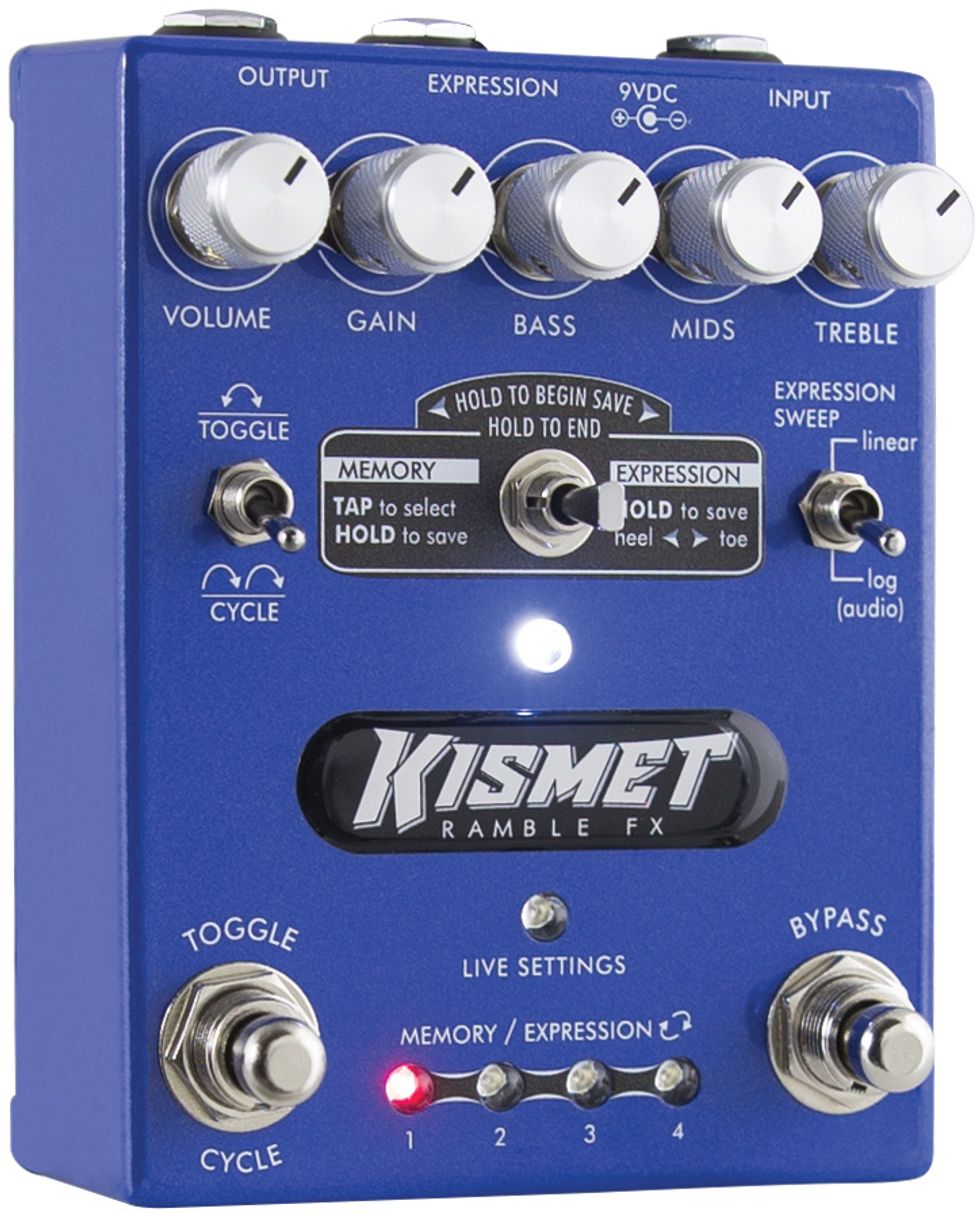RatingsPros:Many beautiful shades of dirt. Toggles are a cool way to save and recall presets. Cons: Slight learning curve for programming. Street: $249 Ramble FX Kismet ramblefx.com | Tones: Ease of Use: Build/Design: Value: |
Ramble FX's Kismet is an analog overdrive with a digital microcontroller. That won't stop certain old-school players from getting nervous—you need only place the words “digital" and “overdrive" near each other for traditionalists to get skeptical fast. But Kismet is a superb overdrive, and the digital capacity to save presets and morph between saved settings using an expression pedal (not included) makes it a genuinely utilitarian and super-expressive overdrive, too.
Don't Fear the Digital (Control)
Digital control isn't the only thing that makes traditional overdrive users nervous, of course. Having lots of knobs typically sparks similar fears. But the many controls on Kismet are not as complicated as they look. The four tiny red LEDs at the bottom of the unit indicate which of the four memory slots is currently in use. The left toggle determines whether you switch between two adjacent presets or cycle through all four. The center toggle helps you store parameters for overdrive presets or assign expression-pedal functions. The rightmost toggle selects between what some might consider a more natural-feeling logarithmic expression-pedal taper and what others might deem a more predictable linear taper. At top are conventional volume, gain, and EQ knobs. One handy feature: If you experiment with new settings in a saved preset but decide you want to find your way back to the knob's original saved position, simply turn the knob till the LED under the logo badge blinks to let you know you've arrived. So while it may all look busy on the surface, my guess is that a lot of players will prefer using Kismet's system of switches rather than the tap-dancing that an alternate design approach might require to manipulate presets.
Savin' for a Stormy Monday
There's a real sense of sonic refinement in the Kismet. Through the whole range of gain, the pedal has great clarity. Basic overdrive tones are typically smooth, chewy, and free of buzzy overtones or harshness. And you can discern more than a hint of Marshall Guv'nor in its tone profile, which works with equal ease for classic rock, heavier '90s indie riffage, or jazz/fusion stylings.
But it's Kismet's programmability that helps you maximize the potential of its fundamentally pleasing distortion. As already mentioned, Kismet enables you to save and recall up to four settings, but Ramble also offers a 3.5 mm stereo-to-5-pin adapter jack that allows you to access 100 saved sounds via MIDI. It can take time to get comfortable programming Kismet in MIDI mode. You can also disappear down a rabbit hole. But once you have it down, the ability to tailor very specific overdrive tones for your needs is fun and inspirational.
Once my presets were saved, I loved switching between scooped rhythm sounds, mid-gain lead tones, and crackling lead textures. Cycling through them in the course of a song opens up worlds of dynamic potential. And the fact that you can do all this with one pedal instead of three means you've got more space for other noise-making devices (or just a lighter board).
Another unconventional feature of the Kismet is the input that enables you to use an expression pedal to shift and morph between settings in the heel and toe positions. Using my Boss FV-500L, I set up a low-gain sound in the heel position and a high-gain sound in the toe position, and the ability to transition between tones in this fashion most certainly prompted me to play outside my usual bag of tricks. I loved playing clean-ish single-note runs then morphing to a heavily distorted sound for climactic high notes. I also wrote call-and-response phrases with clean chords and dirty lead sounds. Sure, some of these moves could be accomplished by switching a simpler dirt pedal on and off, but even with the most seamless switching you would never achieve a feel or taper quite this organic, varied, or full of interesting in-between tones.
The Verdict
I hope the digital-control aspect of Ramble FX's Kismet isn't a deterrent for analog purists, because Kismet has a huge range of stellar, all-analog overdrive sounds, and offers a lot of very practical and creative ways to put them to use. Even if you just used it as a dirt box without touching any of its programming or expression-pedal capabilities, you'd have one hell of a tone machine. But Kismet is much, much more if you want it to be.








![Rig Rundown: Russian Circles’ Mike Sullivan [2025]](https://www.premierguitar.com/media-library/youtube.jpg?id=62303631&width=1245&height=700&quality=70&coordinates=0%2C0%2C0%2C0)

















